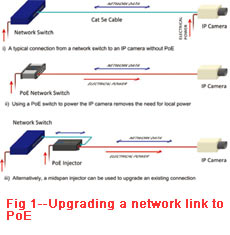PoE compatibility is now a standard feature on most network cameras. Indeed, a growing proportion of IP devices do not offer a conventional power connection at all. This article explores the reasons behind its growth.
PoE compatibility is now a standard feature on most network cameras. Indeed, a growing proportion of IP devices do not offer a conventional power connection at all. This article explores the reasons behind its growth.
Powered devices (PD) receive power from its network connection. These include network cameras, access control panels and card readers, wireless access points and VoIP phones. They must be installed at specific locations — often far from the nearest power outlet, therefore there is a clear benefit in reducing their installation requirements to a single network cable.
Power-sourcing equipment (PSE) is located at the other end of each PD's network cable. These are divided into two types, midspans and endspans, according to their location on the cable. A midspan injector is used to add PoE capability to an otherwise data-only connection. So, typically a network switch channel is patched through a nearby midspan to add PoE capability before the cable run continues out to the PD. An endspan combines both PoE injection and network data connection, and is usually a PoE network switch. In this case, all that is required is a direct network cable connector between the PoE switch and PD.
Optimized Power Delivery
Installers should consider the other advantages PoE offers over conventional power wiring. These advantages include:
* Universal application: The majority of PoE equipment is compatible with the IEEE 802.3af standard. This standard is backwards-compatible with the current standard, but increases device power from 13 watts to over 25 watts. This means that a single cable run can be distributed to several cameras or access panels, or to other powered accessories, such as lamps and door interlocks. Standard Cat 5e or similar cable is used.
* Flexibility of location: Post-installation, cameras or wireless points can be relocated to meet the changing needs of the site, without the time and expense of installing new electrical outlets.
* Safety: PoE employs an isolated and safe voltage level, so the cable does not have to be buried or installed by a qualified electrician. The PSE will only enable power delivery to recognized devices, and will cut power in the case of an overload or short circuit, or if the device is disconnected. Non-PoE devices can be connected to PoE switches and no power will be enabled; the link will just be a regular data connection.
* Efficiency: The PoE voltage is also high enough to carry power efficiently to cameras over a regular gauge network cable. Each PD can have a power class — an indication of how much power it may require — which enables PSEs with a limited budget to allocate it effectively between its ports.
* Reliability: PoE power is standardized and less susceptible to accidental unplugging or loose connectors. Importantly, deploying PoE across a network means that all remote devices draw their power from a single, central source. This means that an uninterruptible power supply (UPS) can be used for backup, and that devices can be disabled and reset remotely.
Enhancing Networks
 All these aspects can be capitalized on when a networked security system is designed. For example, the connection to devices and ease of relocation without new electrical cable means that the installation should be more predictable and repeatable, so that time and expenses can be reduced. Also, device power requirements can be planned and budgeted for with UPS backup if desired.
All these aspects can be capitalized on when a networked security system is designed. For example, the connection to devices and ease of relocation without new electrical cable means that the installation should be more predictable and repeatable, so that time and expenses can be reduced. Also, device power requirements can be planned and budgeted for with UPS backup if desired.
Because power and data are carried on the same cable, this same power can be used for the nodes of the network itself, as well as the powered devices found at its edge. This is relevant to IP surveillance and security networks, where equipment must often be distributed across large sites, whereby Ethernet's 100-meter cable length limit becomes an issue. For such installations, PoE-powered and forwarding Ethernet switches and repeaters can be used to extend and distribute the network across the whole site, with all network power still reliably delivered from a backup central source.